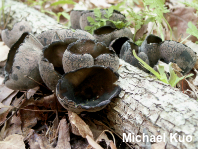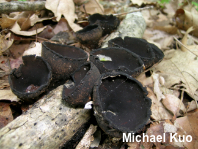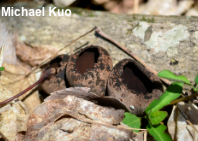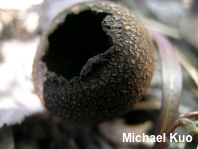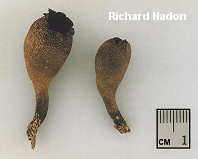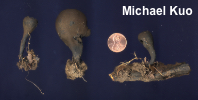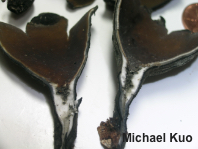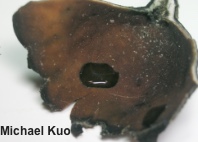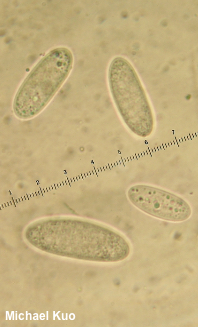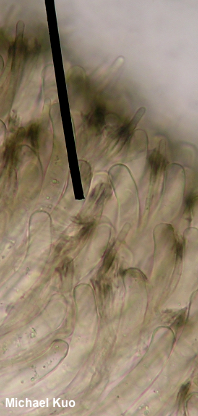| Major Groups > Cup Fungi > Urnula craterium |

|
Urnula craterium [ Ascomycota > Pezizales > Sarcosomataceae > Urnula . . . ] by Michael Kuo Sometimes called the "devil's urn," this distinctive mushroom is a regular feature of the springtime woods, east of the Rocky Mountains. It can be found growing singly or in small clusters, on sticks and small logs—though the wood is often buried, so they appear terrestrial. Urnula craterium can be somewhat variable in appearance, and the relatively tough fruiting bodies can last for many weeks, given the right conditions. The overall shape is urn-like when the mushrooms are young, but the "mouth" of the urn gets wider as the mushrooms mature, and older specimens are often shaped more like goblets or cups. Description: Ecology: Saprobic on sticks and small logs (often buried) of hardwoods; growing alone, scattered, or in dense clusters; spring; widely distributed east of the Rocky Mountains. The illustrated and described collections are from Illinois, Virginia, and Québec. Fruiting Body: 5–9 cm high; 3–9 cm across; at first shaped like a deep cup or an urn with a vaguely defined stem portion; often expanding to goblet-shaped or cup-shaped with age. Fertile (upper, or inner) surface: Dark brown to gray or nearly black; smooth and bald. Sterile (lower, or outer) surface: Brown to gray or nearly black; bald, roughened, or scaly; often becoming finely cracked with age—or with pigments breaking up to form chevron-like or nearly reticulate patterns; the margin becoming lacerated and tattered. Pseudostem: Poorly defined at apex; 3–6 cm high; 0.5–1.5 cm wide; tapering to base; black; fuzzy toward the base. Flesh: White; tough; unchanging when sliced. Odor: Not distinctive. Chemical Reactions: KOH on fertile surface greenish black. Microscopic Features: Spores 21–35 x 9–13 µm; ellipsoid to elongated-ellipsoid; smooth; hyaline in KOH. Asci 8-spored; 150–300 x 10–15 µm; cylindric; hyaline in KOH. Paraphyses 125–325 x 2–4 µm; filiform with rounded, subacute, or subclavate apices; smooth; septate; either hyaline, solitary, and projecting beyond the asci—or with agglutinated brown apices, bundled, and not projecting. Excipular surface elements cylindric; 2.5–6 µm wide; septate; walls black to dark brown in KOH; smooth or a little encrusted; occasionally branching and/or developing lobes or nodules. REFERENCES: (Schweinitz, 1822) Fries, 1851 (Fries, 1822; Saccardo, 1889; Seaver, 1928; Dissing, 1981; Smith, Smith & Weber, 1981. Weber & Smith, 1985; Arora, 1986; Lincoff, 1992; Metzler & Metzler, 1992; Horn, Kay & Abel, 1993; Barron, 1999; Roody, 2003; McNeil, 2006; Miller & Miller, 2006; Kuo, 2007; Binion et al., 2008; Carbone et al., 2013; Beug et al., 2014; Kuo & Methven, 2014; Baroni, 2017; Woehrel & Light, 2017; Elliott & Stephenson, 2018.) Herb. Kuo 03309501, 04300501, 03300601, 05111801. This site contains no information about the edibility or toxicity of mushrooms. |
© MushroomExpert.Com |
|
Cite this page as: Kuo, M. (2018, July). Urnula craterium. Retrieved from the MushroomExpert.Com Web site: http://www.mushroomexpert.com/urnula_craterium.html |
